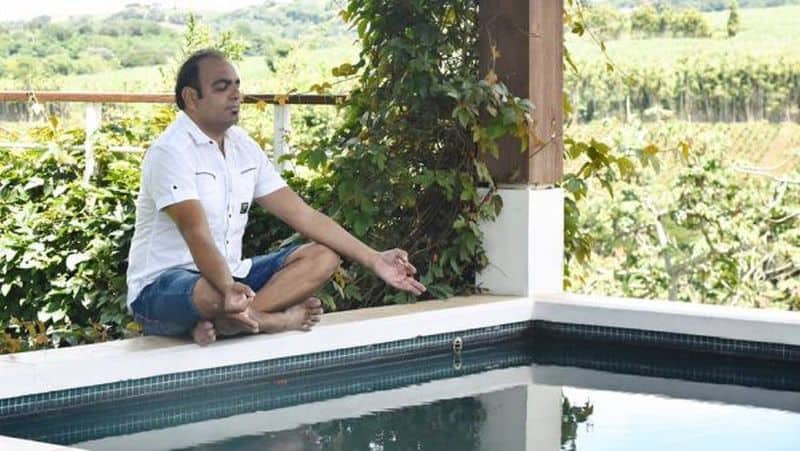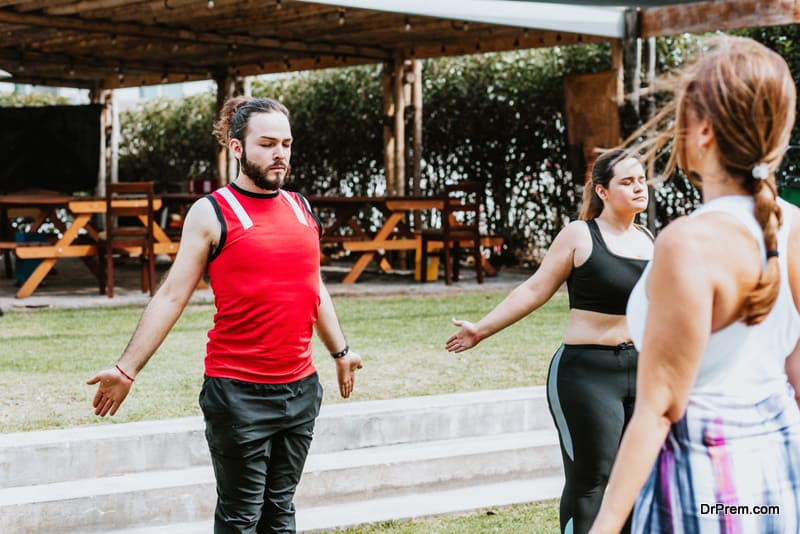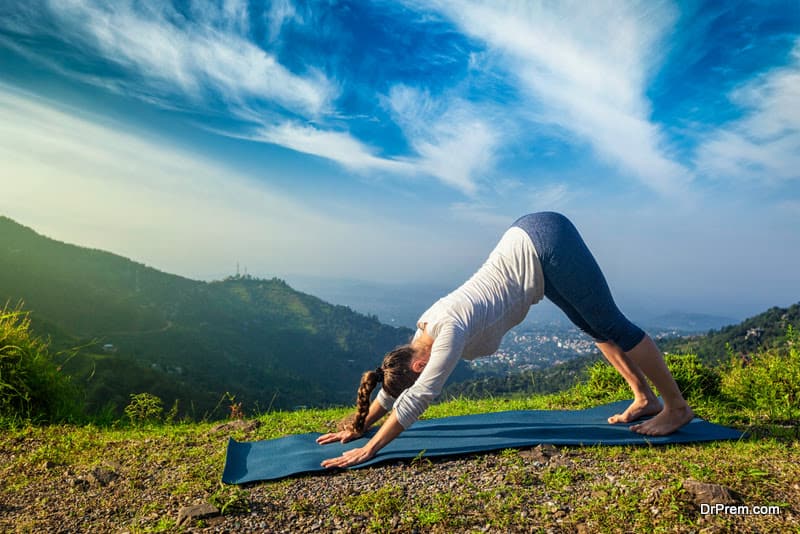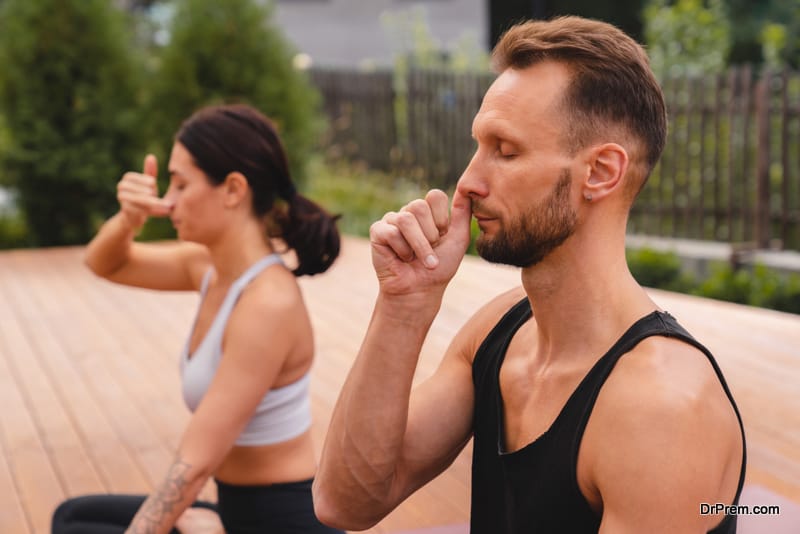Did you know nearly half of the waking hours in our lives get wasted by remaining distracted? We don’t have any count of how much fun, pleasure, and achievements we lose due to this. This is where mindfulness comes into play. Mindfulness has generated a lot of excitement, but the myriad ways it is presented or explained have created more confusion than clarity. This guide to mindfulness aims to help you reap its benefits through simple explanations of the concept and processes.
Simply put, Mindfulness implies being in the present moment. Wellness expert Anna Guchok says, “The application of mindfulness is the key to a full and conscious life.”
Our mind is always in wandering mode. Do you know how many thoughts you process every day? It is an astounding 6000 (2020 Queen’s University Kingston Study)! Some studies say it is 20000-60000!It is chaos out there. We strive and struggle to fulfill tasks one after another without properly focusing on every task. We stop living for the present moment. This agitates our minds and creates the ground for illness.
A Guide to Mindfulness by Dr Prem – Definition, Concept, Benefits, Practices, and Techniques
-
Why are you unmindful most of the time?
-
How did mindfulness evolve?
-
Understanding the concept of Mindfulness
-
What is the difference between mindfulness and awareness?
-
What are the principles of mindfulness?
-
What is the difference between mindfulness and meditation?
-
What are the benefits of mindfulness?
-
Dr Prem’s Signature Technique for Mindfulness
-
Practicing Mindfulness – When and How Many Times?
-
What is the psychotherapeutic approach to mindfulness?
-
What is MBCT (Mindful-based Cognitive Therapy)?
-
What is MBSR (Mindful-Based Stress Reduction)?
-
Common Practices of Daily Mindfulness
-
What is mindfulness in fitness?
-
Mindfulness in Leadership – How mindfulness makes you a better leader, not a boss?
-
Can mindfulness ease our lives?
Why are you unmindful most of the time?
To understand mindfulness better, let us study the word unmindful. Our attention constantly shifts gears, and we lose focus on the present moment. Just recollect when did you last enjoy the beautiful sunshine or admired the beauty of a blooming flower or the flock of birds flying across the sky? Rare. Because hardly your mind is aware of the present moment.
Mindfulness is just the reverse of unmindful or ‘mindlessness’. It means raising the moment-to-moment-awareness and focusing our attention on the present with full acknowledgment and acceptance of our feelings, thoughts, and physical sensations. It means endless reconnection with ourselves and creating harmony with the world.
How did mindfulness evolve?

- The Body (or the breath)
- Feelings and sensations
- Consciousness/mind
- Mental content
Mindfulness may also have historic roots in Judaism, Christianity, and Islam.
In the 1970s, Prof. Jon Kabat Zinn played a significant role in popularizing Mindfulness in the West. He got trained in mindfulness by several notable Buddhist teachers. He founded the Center for Mindfulness at the University of Massachusetts Medical School and the Oasis Institute for Mindfulness-Based Professional Education.
He devised an 8-week-long Mindfulness-Based Stress Reduction (MBSR) program, which gained immense popularity. The same program gave birth to another therapy-based program, Mindfulness-Based Cognitive Therapy (MBCT), to treat people with severe depressive disorder.
The subject roused enough interest in people of all age groups. Several researches established the correlation between mindfulness and reduced stress and improved psychological functioning.
Jon Kabat’s programs and similar models have been used widely in schools, rehabilitation centers, hospitals, sports centers, and centers for senior citizens. These programs help to calm the mind and bring focus to the present moment.
Understanding the concept of Mindfulness

Mindfulness is the ability to hold your awareness being present in the moment with curiosity and compassion.It is about feeling that moment without being judgmental. It is the power to say “Yes” to the present moment.
You will not think about the past or plan for the future. It is about engaging your mind and body in the present happenings around you and consciously shifting your awareness from objects to subjects.
Mindfulness is based on the person’s awareness of present events. Ruminating is ingrained in human nature. The intensity varies from person to person. Studies have shown that rumination is the root of depression and anxiety.
Mindfulness helps to get rid of this habit as we gain more focus and awareness of the present moments. The practice of mindfulness gives you a deeper insight into reality. These are centered on three marks of existence according to the principles of
- Buddhism: Impermanence – Anitya (nothing is permanent)
- Unsatisfaction – Dukkhya (pain or suffering)
- Non-self – Anatta (non-existence of permanent self or soul)
When the practitioner gains insight, they achieve the first state of liberation known as Sotapana and grow the power of overcoming stress, pains, and suffering.
What is the difference between mindfulness and awareness?

How you perceive and recognize objects, events, thoughts, and sensations is your awareness. At a higher level, it also guides you to be proactive. When your mind wanders away from your objective, awareness is the force that brings your attention back to the current situation.
For example, you go shopping to buy something specific. You plan your budget and set out. In the store, you see many more things related to the item you planned to buy.
The temptation is strong, and you decide to purchase them, disregarding both your budget and other financial responsibilities. Your mind has wandered away from your objective. But if you have strong awareness, it will bring your attention back preventing you from crazy spending.
Mindfulness is the deliberate practice of guiding awareness in the present moment. You observe your thoughts, feelings, and sensations with an attitude of acceptance and non-judgment. Mindfulness is an active and engaged form of awareness that cultivates curiosity, openness, and equanimity.
Imagine you are walking in a park. You see the trees, hear birds chirping, and feel the flowing breeze and sun rays. You notice butterflies sitting on flowers. You see people passing by. You are aware of the sights, sounds, and sensations around you without any specific intention. Your attention drifts naturally from one sensation to another.
Now, bring mindfulness to this scenario. While you walk in the park mindfully, you will intentionally direct your attention to present experiences. You may focus on your breath and feel the sensation of air flowing through your nostrils. You might observe the muscle movement and feeling of your legs as you walk.
How do your arms sway as you walk? You might also intentionally focus on the sensation of your feet touching the ground. Additionally, you might be mindful of your thoughts and emotions at that moment without getting stuck in them.
Therefore, awareness encompasses a broader state of perception and feelings while mindfulness is an intention-driven practice to direct your awareness to be fully present in the experience of that moment.
It’s important to note that mindfulness can be seen as a way to cultivate and deepen awareness. By practicing mindfulness, you enhance your overall capacity for awareness, enabling you to be more attentive and responsive.
What are the principles of mindfulness?
Focus on the present moment – Don’t get lost in thinking about the past or worrying about the future.
Being fully present– What are you experiencing around you at present? What are you seeing? What are you hearing? What are your body sensations?
Be open to experience – We always dread or apprehend any experience. But we should welcome these with curiosity. The thoughts and feelings that come up naturally are mere momentary sensations. As you become aware of the flow of your thoughts and sensations, these changes naturally over time preventing you from getting overwhelmed.
Be non-judgmental – Do not judge your feelings as good or bad. You should not even try to change or act on them. Every feeling has an objective. Accept them with an open mind but consciously.
Accept life as it comes to you – Your vision may not fit in reality. Therefore, never force any change in reality and consider yourself a victim of unfairness. Have the strength that you can tolerate any experience that life gifts you. This would give you the strength to extend this acceptance to others.
Be connected – As you practice acceptance, you feel connected with yourself and all animate and inanimate objects around you. You feel thankful for your life and the traits that nature has endowed on you.
Practice non-attachment – Nothing is permanent as life is a continuous flow. Never hold on to anything, people, and experiences. Attachment breeds worry and fear. Be confident enough to adapt to the flow of life.
Maintain equanimity– Life brings you highs and lows. Never get swept away in this tide. These situations do not present the entire scenario. Be firm in your vision and values, and you walk away with a peaceful heart and a non-harming attitude.
Extend your compassion – Never criticize or punish yourself or others. Be compassionate. Understand your capabilities and accept them. Understand others’ situations instead of condemning them.
What is the difference between mindfulness and meditation?

Meditation is an intention-driven practice where you focus on inducing calm, emotional balance, concentration, and awareness. Mindfulness, on the other hand, means paying attention to the present moment on what you are doing or what is happening.
Meditation needs a specific ambiance where you can sit still for a specific time to calm yourself, clear your brain, or gather your thoughts. You will typically spend a specific time from a few minutes to an hour or more.

Mindfulness is not a tool to eliminate your life’s challenges and difficulties but to make you have better control of the situation good or bad. It improves your ability to make proper judgments according to situational demands.
Meditation and mindfulness are complementary to each other. Practicing mindfulness during formal meditation makes you more mindful.
What are the benefits of mindfulness?

- Mindfulness changes the brain’s anatomy. Your gray matter increases, helping in improved memory, learning, and focus.
- Mindfulness can reduce stress significantly.
- Mindfulness can cultivate empathy and compassion.
- Mindfulness can help in better emotional control.
- Mindfulness can reduce anxiety and improve positive self-talk.
- Mindfulness CBT helps in reducing depression significantly.
- Mindfulness can reduce subconscious bias
- Mindfulness can boost productivity with improved focus and attention.
- Mindfulness can reduce pain by 50%.
- Mindfulness can improve decision-making.
- Mindfulness can boost creativity and help in problem-solving.
- Mindfulness can improve relationships among couples.
- Mindfulness can improve our perception of wellness.
- Mindfulness can enhance spirituality.
- Mindfulness can reduce social anxiety and foster social connections.
- Mindfulness can increase satisfaction in the workplace.
- Mindfulness can reduce negative self-talk
- Mindfulness can help get rid of substance abuse.
- Mindfulness can improve sports performance.
- Mindfulness can help survivors of childhood assault
- Mindfulness can help manage ADHD.
Dr Prem’s Signature Technique for Mindfulness

What matters more is your attitude. You cannot stop your brain from thinking or wandering. This is a wrong approach to mindfulness. Perhaps, this deep-rooted perception holds people back from the practice of mindfulness.
Remember mindfulness is our innate trait. We just need to nurture it. We do exhibit a certain degree of mindfulness through our various activities. Don’t you get lost while reading an interesting book or watching an exciting movie? You become so engrossed that you become oblivious to what is happening around you.
Your full attention remains on the present happening. To practice mindfulness, you do not need any formal setting. You can do it at your home any time of the day that suits you best. You can go for a nature walk or practice meditation regularly. The objective remains the same – to achieve a state of mental awareness through focused relaxation.
Position yourself comfortably

Follow your breath – Inhale and Exhale

As you inhale and exhale, do the following steps to achieve mindfulness. Follow your breath at every step.
Mindfulness of Thoughts
Feel the surroundings – the sound you hear, the air you feel. Feel the body sensations, the temperature of your palms touching your lap. Feel the way you are sitting.
Observe how your thoughts are wandering from one thought to another. Let them wander. Let thoughts, positive or negative, come to you. Do not judge them. Do not fight with them. Pay attention to these thoughts. Then let it go as you exhale through your mouth.
Repeat 2-3 times.
Mindfulness of Gratitude

You can also think about a situation that made you happy and be thankful for it. You express gratitude by staying mindful at that moment. You can pay gratitude to the universe or the higher spiritual being whatever you follow.
Repeat 2-3 times.
Mindfulness of forgiveness

As you exhale, say to yourself that I am letting go of that person and the thought from my mind forever. Feel the joy of forgiveness. Feel the inner peace.
Repeat 2-3 times.
Mindfulness of problems
We all have problems in our lives. This step to mindfulness will help you accept problems boldly and seek solutions instead of filling you with dread and scare. As you inhale, think about the problems and be kind to yourself. Do not blame yourself or anybody or the situation that has created this problem.
You may have problems in your relationships, finances, health, and well-being or at your job. Acknowledge the problems the way they are. Do not fight with them. Observe your problem with compassion for yourself. Release your breath.
Take a deep breath and feel the power that you can deal with this problem since you have dealt with many problems in your life earlier. Release your breath.
Observe your inner capability with the power to deal. Feel the joy of your capability as if you have found the solution to the problem.
Repeat 2-3 times.
Mindfulness of connection

As you release your breath, feel the connections that you can touch and those that you can’t. It might be the feeling of touching your kid’s soft hand or hugging your friend or partner. Feel the connection with the higher being whom you can neither see nor touch.
Think about the greater connections beyond your comprehension. Think about how you are connected with the purpose of your life. Accept that you have something in your life to pursue and serve a purpose.
Repeat 2-3 times.
Mindfulness of non-judgmental

Just allow them to be who they are. Free them from your judgment. Do not try to find good and bad things about them. Try not to associate any emotions or feelings with them.
Repeat 2-3 times.
Mindfulness of non-attachment

Repeat 2-3 times.
Mindfulness of Love

Say to yourself – “I love others”. Affirm that you love everyone and everything for what they are. Release your breath as you accept them as they are.
Repeat 2-3 times.
Mindfulness of Empowerment

Feel the control you have over yourself. Feel the power that you can change the situation. Nothing can derail you from that control. Feel the power of the outer universe that can answer any questions you have.
Mindfulness of Joy

Mindfulness is about being aware of the present and training your mind to hold the awareness. It is not about getting thoughtless. On the contrary, it is a deliberate process to welcome thoughts without putting any fight (that is getting judgmental).
Flowing water gets turbulent or forceful when it gets clogged or passes over obstructions like big rocks or undulating plains. When the plain is smooth, water flows gently. Similarly, when you open your mind more to accommodate the flowing thoughts without creating obstructions with your judgments, it gradually becomes a smooth flow without building any stress.
Practicing Mindfulness – When and How Many Times?

Fixing a time for mindfulness has its benefits. People normally choose early morning or late night for this. If you feel burnout, restless, overwhelmed, or fatigued at any time of the day, take a 3-5-minute mindfulness break. Just see the magic. Your productivity will shoot and your stress will ebb.
Avoid infrequent practice. What you gain from a 1 or 2-day mindfulness practice, you lose it when you break the practice. Better to start in a small way, say, allotting 2–3 minutes.
Building your capacity for mindfulness helps you to lead a more satisfying life. You become more observant in what you do and think. By practicing mindfulness, you align your thoughts and actions. Relaxation is not the end goal of mindfulness practices though it is one of the outcomes.
What is the psychotherapeutic approach to mindfulness?

The therapeutic approach is centered around two research-backed mindful training programs:
- MBSR (Mindfulness-Based Stress Reduction)
- MBCT (Mindfulness-Based Cognitive Therapy)
What is MBSR (Mindful-Based Stress Reduction)?
Prolonged stress can create irreversible damage to your physical and mental health. MBSR is often used as the single mode of therapy for stress management in individuals without any significant mental illness. It can be combined with other treatments in individuals suffering from chronic anxiety and other mental issues.
This program was developed by Jon Kabat Zinn in the 1970s to treat people struggling with difficulties related to physical and mental illness. Although the program was designed to aid hospital patients, it has been proven to be beneficial for individuals from all walks of life.
MBSR covers the following techniques:
- The Breath – Follow the breath as you inhale and exhale.
- Body Scan – Shift your awareness throughout the body by focusing on each part at a time.
- Object Meditation – Focus on a special or interesting object and observe the sensations you feel as you look at different parts of it.
- Mindful Eating – Focus on the food on your plate and feel the sensation of its flavor, texture, taste, touch, and sound.
- Walking Meditation – Walk at a gentle pace. Observe how your feet and hands are moving. Feel the sensations of muscle movement, breaths, and sweat.
- Mindful stretching – Feel the sensation of your nerves and muscles and breaths while you stretch different parts of your body.
What is MBCT (Mindful-based Cognitive Therapy)?
MBCT is a combination of cognitive therapy and meditation. It is an effective therapeutic tool to successfully treat depression, anxiety, bipolar disorder, and more.MBCT was crafted by Mark Williams, Zindel Segal, and John Teasdale, taking inspiration from the earlier works of Philip Barnard, Teasdale, and Jon Kabat-Zinn.
This 8-week Group Therapy Program has helped many individuals find solace from symptoms of mental disorders. Amid supportive settings, participants gather for two hours every week to unravel the secrets of mental well-being. Other than this, they spend six days a week on homework, which involves meditation, audio-guided mindfulness exercises, and techniques such as 3-minute breathing.
Other recommended MBCT techniques are:
- Body Scan
- Mindfulness stretching
- Yoga poses
Common Practices of Daily Mindfulness

Mindful Brushing

Mindful Shower
This is another easy mindfulness practice. Focus on the temperature of the water as it flows over your body. How does it feel when the water jet hits your body first? Observe the smell of your body wash and shampoo. Feel the sensation on your skin as you scrub your body.
Watch your skin drying as you wipe the water droplets gently with a towel. Focus your attention on every bit of activity during and after the shower. If you do any pre-shower ritual, observe those sensations as well.
Mindful Eating

Mindful cooking

Mindful listening

Similarly, you can try mindful dishwashing, mindful bed-making, mindful journaling, mindful reading, and many things to make mindfulness a part of your life.
What is mindfulness in fitness?
In today’s wellness space, mindfulness and fitness walk together. Wellness demands you to be mindful in fitness. People are incorporating mindfulness in workouts which is evolving as moving meditation or shaking meditation. The basic concept remains the same – you remain more in the present while exercising, dancing, jogging, or running on your treadmill.
If your fitness journey is aimed at weight management, incorporating mindfulness would add more value. Your goal shifts to more than weight management where you start moving your body in a way to support other wellness aspects of life.
Your mindset gets changed from achieving a specific body image toyour entire physical and mental being. You take the holistic path to wellness. It is no doubt proper body movement aids in flexibility and functionality but when you add love and due attention to the feelings during the movement, the benefits are manifold. Fitness coaches are using mindfulness in their training programs to build both physical and mental wellness.
Mindfulness in Leadership – How mindfulness makes you a better leader, not a boss?

- You are always in the present moment with your staff
Mindfulness helps you to remain focused on a task and motivate others to do so. You avoid distractions. Your undivided attention ups your teamwork helping in achieving targets faster.
- You shun your ego and see things with objectivity
The ego is a big barrier to leadership. Mindfulness helps to get past your ego and drops the tendency to take things personally. You do not get defensive about criticism.
- You connect better and form deeper relationships
You cultivate empathy and a deeper level of understanding. You feel connected with everybody and have less adversarial feelings. You deal better with tough colleagues or staff.
- You communicate goals not dictate
Mindfulness helps you to take a pause to deliver your thoughts effectively. You become a better listener and can create responsive, not reactive dialogues.
- You become a good observer, not an imposer
Practicing mindfulness cultivates your observation skills, enabling you to better recognize the potential of your staff. You allow them to speak their minds and give them more authority.
- You show better emotional responses during crisis
You recognize your feelings and emotions and have control over them. You are more aware of its impact and handle emotional responses better in crisis.
- You build rationale in criticism
Leaders are often the harshest critics of themselves. Mindfulness helps you to be kind to yourself. You build a realistic approach to setting targets and prevent frustration-building.
The reasons are clear why the world’s top leaders have embraced mindfulness.
Can mindfulness ease our lives?

For example, if your brain receives emotionally upsetting information, mindfulness can help you disengage from that emotion, helping you engage better in cognitive tasks. The more mindful we are, the more we fare better in logical deduction, perception building, and decision-making.
Conclusion
Mindfulness gives direction to our turbulent minds. It offers an anchor guiding us to the path to balance and harmony. By practicing being fully present in the moment, we awaken our senses and build a deeper connection with self and the world. Every mindful breath that you take can transform your life!
About Dr Prem
Dr Prem is a globally renowned wellness expert consultant with a passion for guiding individuals on their journey to mental well-being. He has traveled to 65+ countries and conducted top-notch wellness masterclasses and workshops. His wellness consultancy has helped several businesses and corporates successfully incorporate mindfulness in their organizations for enhanced engagement and individual fulfillment. Reach out to us today.


















